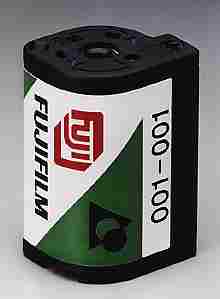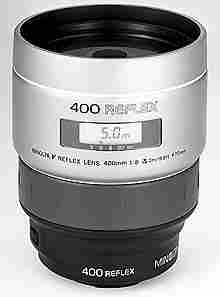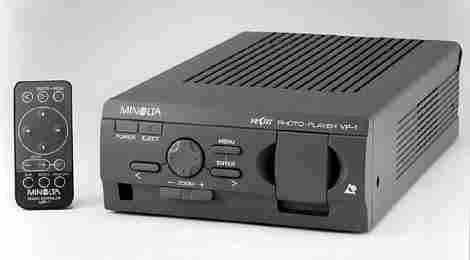
The main launch of new APS (a term we asked not to use by the Advance Photo System consortium, presumably because it's someone else's trademark) came in February after a year of demonstration and development aimed mainly at the photofinishing industry. One manufacturer alone showed exactly why APS will succeed.
While Fuji, Kodak and Nikon launched predictable compact cameras with or without zooms of varying range, Minolta showed the Vectis S-1 single-lens reflex system which uses a body almost identical in length and height to the Leica/Minolta CL and just a little fatter (and yes, the key member of their design team from Japan turned up to dinner carrying just that - a Minolta CLE). Combined with lenses comparable to rangefinder designs in size, but far lighter and incorporating wide zoom ranges, the Vectis S-1 has been sufficient to persuade most of those who handled it that APS does have a future.

The Minolta Vectis line-up with the SLR S-1 at the front
Despite the merits of Advanced compact cameras, and the superb design of most of them, I see no special relevance of these to Photon's readership. You may well decide to buy one, and make some use of its versatility, but the transition from a good 35mm compact to one of these will be seamless.
It is the Vectis S-1 and its likely competitors in the APS SLR market which really begin to look exciting.

The IX240 film cassette (Fuji pre-production photograph)
To enable you to �see' the negatives or slides on each cassette, a digitally mastered index print is created. This contact sheet is your reference for ordering prints. However, a far superior method exists in APS film-scanner players for computer or television monitoring. These will accept a simple encoding to show selected frames, with dissolve or wipe effects, as a TV slide programme, and can also rewrite print ordering data on to the magnetic layer of the film. This can include format, print size and number of enlargements from each frame - functions which the camera has initially �written' at the time of photography, but which are subsequently re-writable.
The rewindable cassette with data encoding also means that the film itself records how many frames have been used, and the camera can read this information without the film being processed. In �serious' APS cameras like the Vectis S-1, loading is arranged to make it easy to slot cassettes in and out without removing the body from a tripod. You can carry as many films as you like - colour negative of different speeds, slide, black and white if it's ever available - and repeatedly switch films without losing a frame or risking double exposures.
A film can be kept for a project - recording the foliage on a tree every week at the same time - without affecting your ability to unload and shoot anything else you like. You can avoid the expense of unwanted prints, because any frame which clearly failed can be coded for non-printing before you unload the camera; you can avoid the need for multiple prints off a whole roll by entering the number of first-off prints required, at the time of exposure. Thus a group shot with four people can be programmed so that four prints are made, while a shot with no need for reprints gets a single proof.

The tiny prototype Vectis V-lens 400mm f8 mirror
Any professional who can't see the implications of this technology - where the film itself replaces multiple camera bodies, interchangeable backs, and whole stages of proofing and print ordering - must be very blinkered indeed. Add the ability to program in captions back-printed by the lab machinery, auto date stamping and technical data recording by the same method, copyright watermarking, front printing, whatever you choose�
The Advanced Photo System, as previewed by Minolta's Vectis S-1 with its library of stock phrases like Happy Birthday to print in thirteen languages, starts here as a consumer product. Personally, I am delighted; I've used Minoltas since 1975 and often felt that I might have hitched my cart to the wrong horse when I listen to professionals assuming that Canon or Nikon might be in some way better. I feel as good now about being associated with Minolta as I did when the first AF SLR appeared - they've got something impossible to put down.
All the data recording, back printing, mid-load changing and other functions would need no new investment - the chips, silicon variety, are already down. There are 46mm coating lines in existence. Imagine a 'rollfilm APS' SLR needing no film magazines and at least as light and compact as the smallest 645 model yet made, but capable of being programmed to shoot and print for 6 x 8s, 8 x 8s, or even panoramic 3.5 x 10" prints on the same roll.

The Minolta VP-1 film player - Fuji have an identical model, and so will most makers - is a scanner, slide show and order reprogramming system all in one
Imagine clients who are used to ordering from contact sheets because that's exactly what they now get as 'index prints' from their APS camera at home. Imagine them used to viewing work on a TV monitor through their APS film player - and able to select their own reprints using a terminal on your studio's reception counter, while their negatives are safely inside a cassette which only the photographer can ever keep, because they can't be cut up.
Copyright and ownership of originals is enhanced by APS - unless you give the entire film away, you keep the negs; transfer of a working copy is most likely to be by scanning. Even the scan can have your copyright data encoded on it. These things are possible with APS and must surely be demanded by professionals for 'giant APS'.
Finally, dust-free and finger-free film handling is a dream. I have always said that small formats may be able to produce wonderful enlargements, but Nature provides dust, hairs and fingerprints to a fixed scale - the main reason why 5 x 4 is far more practical than 16mm. Eliminate dust, processing marks and handling and a small rollfilm format will be all we need for 99 per cent of regular work.
What you have here, from me, amounts to another round of Chinese whispers. But we do need these reinforcements. And from the look of it, we are going to a dance.
- David Kilpatrick